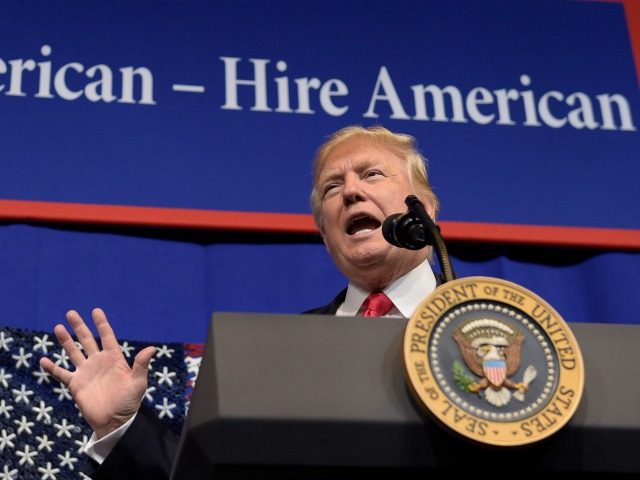President Donald Trump’s populist “Hire American” policy is forcing employers to hire more Americans at higher wages, the Wall Street Journal admits.
The pressure is highlighted by seasonal employers in Massachusetts who were forced to hire Americans when Trump’s populist coalition stymied their lobbying efforts to expand the use of H-2B foreign contract workers. According to the Journal, which has long urged the large-scale use of foreign workers:
“I have more Americans working than I’ve ever had,” says Josh Aronie, executive chef at the Home Port Restaurant in the Vineyard fishing village of Menemsha. He also reports his restaurant has been short of staff and many of the workers he does have don’t know the basics of cooking or even how to read the orders…
Nationwide data on the leisure and hospitality sector also shows a tightening labor market. In June, average hourly earnings in the sector increased 4% from a year earlier, according to government data analyzed by Moody’s Analytics …
At the Home Port Restaurant in Menemsha, Mr. Aronie recalls meeting with his small staff in a panic this June just a few days before the scheduled opening. He had applied for 18 H-2B visa workers and received none. Because of the staffing crunch, the restaurant initially was open just five nights a week, and didn’t open for lunch until late July. Mr. Aronie jokes about the qualification he requires for hiring: “Are you breathing? Excellent.” He has paid a premium to hire three people via a Boston-based temp agency.
Many seasonal employers prefer to hire H-2B workers instead of Americans because those visa workers must stay with the company for the entire season and must work at government-set hourly rates. Those lower rates for seasonal workers also allow employers to pay lower rates to full-time, year-round American staff.
Employers also prefer foreign workers because the current pool of unemployed Americans includes many immature and untrained youths, unmotivated adults on government aid programs, plus marginalized Americans, such as inner-city youths and unemployed drug users who are the customers of the Mexican drug cartels.
Amid pressure from donors, GOP leaders tried this year to expand the H-2B program from roughly 115,000 H-2B workers up to roughly 200,000 resident H-2B workers. But the lobbyists and GOP leaders — including House Speaker Paul Ryan — were largely blocked by John Kelly when he was serving as the secretary of the Department of Homeland Security. Kelly allowed only an extra 15,000 H-2B workers, and promised to oppose any increase in 2018.
The public’s opposition to greater use of H-2B has also forced employers in other states to recruit and pay Americans. The Journal reported:
In Alaska, Silver Bay Seafoods, a big user of the program, received 31 H-2B visas this year for workers to help process salmon, down from more than 900 in 2016. The company responded by spending more than $1 million to recruit workers in 32 states, plus U.S. territories such as Puerto Rico and the U.S. Virgin Islands.
“It’s very difficult to find people to do this work,” says Joe Misenti, general counsel for Silver Bay. The company succeeded in hiring about 1,600 workers, replacing all of the foreign workers with Americans, counting those from the U.S. territories.
Read it all here.
The same trend is visible in the agriculture sector, where the loss of cheap illegal aliens is forcing employers to raise wages and also to hire Americans to build and operate labor-saving farm machinery.
The result of the H-2B fight boosts the growing evidence that young Americans will gain if the federal government reduces the annual inflow of foreign temporary workers.
In 2016, for example, federal data shows that former President Barack Obama gave federal “Employment Authorization Document” work permits to at least 2.3 million migrants for U.S. jobs, and approved visas for roughly 500,000 outsourcing workers, such as the H-1B white-collar workers, H-2B blue-collar workers and H-2A agriculture workers. Those temporary workers were in addition to the routine inflow of 1 million legal immigrants and roughly 400,000 illegal immigrants.
The combined inflow delivered almost 4 million legal foreign workers to Americans’ economy in 2016, just as 4 million young Americans turned 18 and began looking for decently paid jobs.
Many polls show that Americans are very generous, they do welcome individual immigrants, and they do want to like the idea of immigration. But the polls also show that most Americans are increasingly worried that large-scale legal immigration will change their country and disadvantage themselves and their children.
The current annual flood of foreign labor spikes profits and Wall Street values by cutting salaries for manual and skilled labor offered by blue-collar and white-collar employees. It also drives up real estate prices, widens wealth-gaps, reduces high-tech investment, increases state and local tax burdens, hurts kids’ schools and college education, and sidelines at least 5 million marginalized Americans and their families.

COMMENTS
Please let us know if you're having issues with commenting.